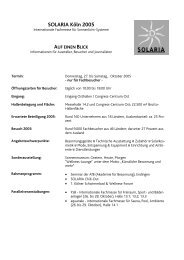2006;56;106-130 CA Cancer J Clin Smigal and Michael J. Thun ...
2006;56;106-130 CA Cancer J Clin Smigal and Michael J. Thun ...
2006;56;106-130 CA Cancer J Clin Smigal and Michael J. Thun ...
Create successful ePaper yourself
Turn your PDF publications into a flip-book with our unique Google optimized e-Paper software.
<strong>Cancer</strong> Statistics, <strong>2006</strong><br />
<strong>Cancer</strong> Statistics, <strong>2006</strong><br />
Ahmedin Jemal, DVM, PhD; Rebecca Siegel, MPH; Elizabeth Ward, PhD; Taylor Murray;<br />
Jiaquan Xu; Carol <strong>Smigal</strong>, MPH; <strong>Michael</strong> J. <strong>Thun</strong>, MD, MS<br />
Dr. Jemal is Program Director, <strong>Cancer</strong><br />
Occurrence, Department of Epidemiology<br />
<strong>and</strong> Surveillance Research, American<br />
<strong>Cancer</strong> Society, Atlanta, GA.<br />
Ms. Siegel is Manager, Surveillance<br />
Information Services, Department<br />
of Epidemiology <strong>and</strong><br />
Surveillance Research, American<br />
<strong>Cancer</strong> Society, Atlanta, GA.<br />
Dr. Ward is Director, Surveillance Research,<br />
Department of Epidemiology<br />
<strong>and</strong> Surveillance Research, American<br />
<strong>Cancer</strong> Society, Atlanta, GA.<br />
Mr. Murray is Manager, Surveillance<br />
Data Systems, Department of<br />
Epidemiology <strong>and</strong> Surveillance Research,<br />
American <strong>Cancer</strong> Society,<br />
Atlanta, GA.<br />
Mr. Xu is Epidemiologist, Mortality<br />
Statistics Branch, Division of Vital<br />
Statistics, Centers for Disease Control<br />
<strong>and</strong> Prevention, Hyattsville, MD.<br />
Ms. <strong>Smigal</strong> is Epidemiologist,<br />
Department of Epidemiology <strong>and</strong><br />
Surveillance Research, American<br />
<strong>Cancer</strong> Society, Atlanta, GA.<br />
Dr. <strong>Thun</strong> is Vice-President, Department<br />
of Epidemiology <strong>and</strong> Surveillance<br />
Research, American <strong>Cancer</strong><br />
Society, Atlanta, GA.<br />
This article is available online at<br />
http://<strong>CA</strong>online.Am<strong>Cancer</strong>Soc.org<br />
INTRODUCTION<br />
ABSTRACT Each year, the American <strong>Cancer</strong> Society estimates the number of new cancer cases<br />
<strong>and</strong> deaths expected in the United States in the current year <strong>and</strong> compiles the most recent data on<br />
cancer incidence, mortality, <strong>and</strong> survival based on incidence data from the National <strong>Cancer</strong> Institute<br />
<strong>and</strong> mortality data from the National Center for Health Statistics. Incidence <strong>and</strong> death rates are<br />
age-st<strong>and</strong>ardized to the 2000 US st<strong>and</strong>ard million population. A total of 1,399,790 new cancer<br />
cases <strong>and</strong> <strong>56</strong>4,830 deaths from cancer are expected in the United States in <strong>2006</strong>. When deaths are<br />
aggregated by age, cancer has surpassed heart disease as the leading cause of death for those<br />
younger than age 85 since 1999. Delay-adjusted cancer incidence rates stabilized in men from 1995<br />
through 2002, but continued to increase by 0.3% per year from 1987 through 2002 in women.<br />
Between 2002 <strong>and</strong> 2003, the actual number of recorded cancer deaths decreased by 778 in men,<br />
but increased by 409 in women, resulting in a net decrease of 369, the first decrease in the total<br />
number of cancer deaths since national mortality record keeping was instituted in 1930. The death<br />
rate from all cancers combined has decreased by 1.5% per year since 1993 among men <strong>and</strong> by<br />
0.8% per year since 1992 among women. The mortality rate has also continued to decrease for the<br />
three most common cancer sites in men (lung <strong>and</strong> bronchus, colon <strong>and</strong> rectum, <strong>and</strong> prostate) <strong>and</strong><br />
for breast <strong>and</strong> colon <strong>and</strong> rectum cancers in women. Lung cancer mortality among women continues<br />
to increase slightly. In analyses by race <strong>and</strong> ethnicity, African American men <strong>and</strong> women have<br />
40% <strong>and</strong> 18% higher death rates from all cancers combined than White men <strong>and</strong> women, respectively.<br />
<strong>Cancer</strong> incidence <strong>and</strong> death rates are lower in other racial <strong>and</strong> ethnic groups than in Whites<br />
<strong>and</strong> African Americans for all sites combined <strong>and</strong> for the four major cancer sites. However, these<br />
groups generally have higher rates for stomach, liver, <strong>and</strong> cervical cancers than Whites. Furthermore,<br />
minority populations are more likely to be diagnosed with advanced stage disease than are<br />
Whites. Progress in reducing the burden of suffering <strong>and</strong> death from cancer can be accelerated by<br />
applying existing cancer control knowledge across all segments of the population. (<strong>CA</strong> <strong>Cancer</strong> J <strong>Clin</strong><br />
<strong>2006</strong>;<strong>56</strong>:<strong>106</strong>–<strong>130</strong>.) © American <strong>Cancer</strong> Society, Inc., <strong>2006</strong>.<br />
<strong>Cancer</strong> is a major public health problem in the United States <strong>and</strong> other developed countries. Currently, one in<br />
four deaths in the United States is due to cancer. In this article, we provide an overview of cancer statistics, including<br />
updated incidence, mortality, <strong>and</strong> survival rates <strong>and</strong> expected number of new cancer cases <strong>and</strong> deaths in <strong>2006</strong>.<br />
Downloaded from caonline.amcancersoc.org by guest on September 27, <strong>2006</strong> (©American <strong>Cancer</strong> Society, Inc.)<br />
MATERIALS AND METHODS<br />
Data Sources<br />
Mortality data from 1930 to 2003 in the United States were obtained from the National Center for Health<br />
Statistics (NCHS). 1 Incidence data (1975 to 2002), 5-year relative survival rates, <strong>and</strong> data on lifetime probability of<br />
<strong>106</strong> <strong>CA</strong> A <strong>Cancer</strong> Journal for <strong>Clin</strong>icians



![811 IARC vitamin D and Cancer Report_VitD[1] - Sunlight Research ...](https://img.yumpu.com/25304592/1/184x260/811-iarc-vitamin-d-and-cancer-report-vitd1-sunlight-research-.jpg?quality=85)











